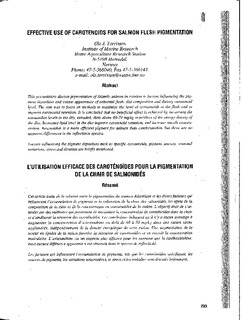| dc.contributor.author | Torrissen, Ole | |
| dc.date.accessioned | 2008-06-09T08:08:39Z | |
| dc.date.issued | 1996 | |
| dc.identifier.issn | 1203-8881 | |
| dc.identifier.uri | http://hdl.handle.net/11250/109450 | |
| dc.description.abstract | This presentation discuss pigmentation of Atlantic salmon in relation to factors influencing the pigment deposition and colour appearance of salmonid flesh, diet composition and dietary carotenoid level. The aim was to focus on methods to maximise the level of carotenoids in the flesh and to improve carotenoid retention. It is concluded that no beneficial effect is achieved by increasing the astaxanthin levels in the dry, extruded, diets above 60-70 mg/kg regardless of the energy density of the diet. Increased lipid level in the diet improve carotenoid retention, and increase muscle concentration. Astaxanthin is a more efficient pigment for salmon than canthaxanthin, but there are no apparent differences in the reflectance spectra. Factors influencing the pigment deposition such as specific carotenoids, pigment sources, seasonal variations, stress and diseases are briefly mentioned. | en |
| dc.format.extent | 628070 bytes | |
| dc.format.mimetype | application/pdf | |
| dc.language.iso | eng | en |
| dc.publisher | Canadian Feed Industry Association | en |
| dc.relation.ispartofseries | Eastern nutrition conference | en |
| dc.relation.ispartofseries | 1996 | en |
| dc.title | Effective use of carotenoids for salmon flesh pigmentation | en |
| dc.type | Conference object | en |
| dc.source.pagenumber | 9 s. | en |
